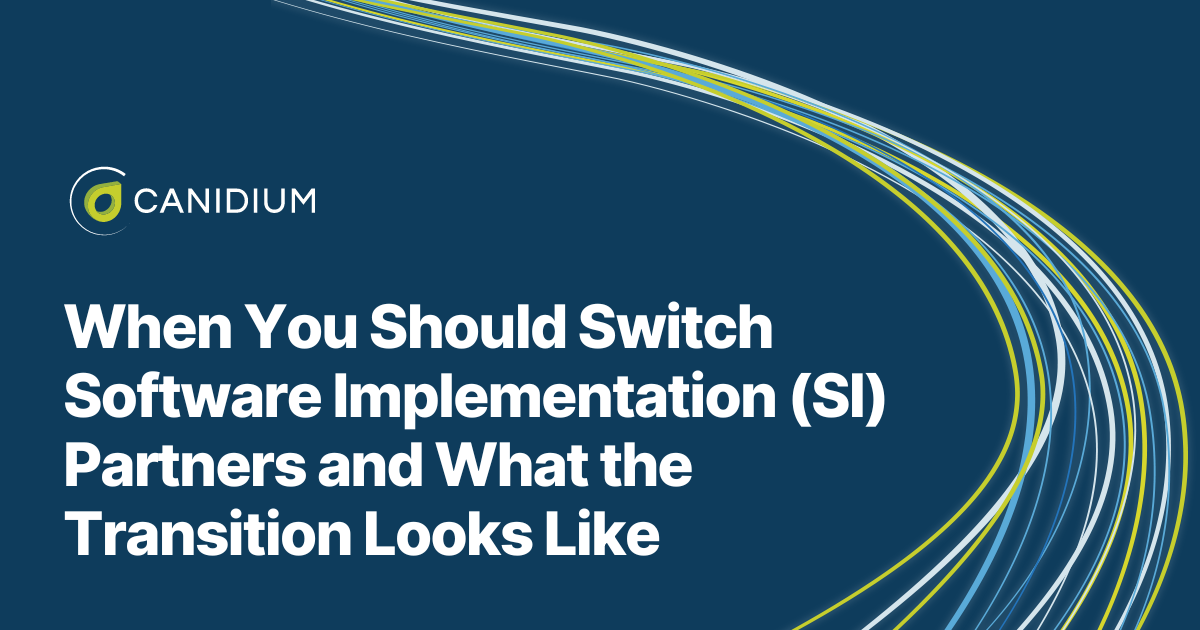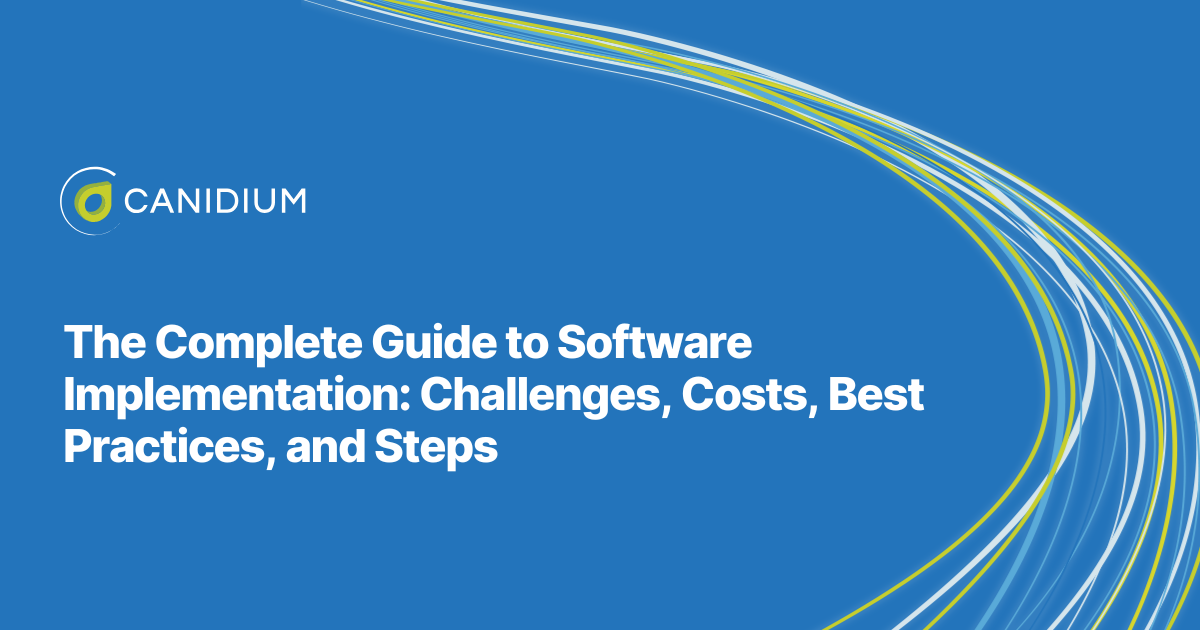Software implementations are costly. You have likely already sunk significant time, effort, and money into your ongoing implementation. Still, your investment might not be paying off.
Properly designing, implementing, and managing a new solution is exceedingly complex, and things will sometimes go contrary to plan. But in some cases, you may realize that your current software implementation (SI) partner may not be the right fit for your project. Getting the implementation back on track may seem infeasible, leaving your organization deeply invested with nothing to show.
At Canidium, our implementation experts have encountered and overcome all the challenges that software design and configuration may create. We deeply understand where implementation partnerships can go wrong, when to make a change, and how to get a project back on track after a significant setback.
Based on this expertise, this article deals with the realities of switching SI partners. It covers when to switch SI partners, the challenges of the transition, finding a new team, onboarding them, and the first steps toward planning your project.
Why You Might Need to Switch SI Partners
Enterprises are adopting advanced digital solutions with increasing urgency. The potential competitive edge of green-lighting innovative software implementations before other companies beat you to it is enticing. However, software implementations are more complex investments and can go wrong.
Implementing solutions can be challenging—resulting in a high project failure rate. Only 16.2% of software projects are completed on time and budget, and 14% fail entirely. However, the costs of project failure and low-quality implementations are untenable for many businesses. In 2020, the estimated total cost of poor software quality in the US was $2.08 trillion.
The long-term costs of choosing the cheapest software implementation partner can far exceed the fees of a more experienced SI team. Switching SI partners during implementation is best if you notice alarm bells within your current project.
There are two common reasons companies find themselves unhappy with their SI partnership:
First, the relationship might not meet your expectations of competency and trust. This gap can manifest in various ways, including service quality. A single failed project can often be enough to sour the entire relationship, prompting both parties to seek a fresh start elsewhere.
Secondly, many firms are increasingly adopting offshore models to manage costs, which can inadvertently diminish the value of their services. This cost-cutting measure often leads to a transactional approach, fulfilling requests without offering additional insights or advice, which could significantly impact the overall value you receive.
Professional engagements are about getting the job done and receiving consultative advice and best practices to guide better decision-making. You should expect more than just someone turning a wrench. Unsuccessful partnerships come in all shapes and sizes. Switching your SI partner is often the best course of action if there's a disconnect in expectations, communication, or timelines.
The Challenges of Switching SI Partners During an Implementation
Changing your service provider comes with significant costs, including losing knowledge, time, and financial resources. The fear of losing team members who have been integral for the past year and the setback of starting fresh with a new firm is daunting. It means losing accumulated knowledge and spending time, energy, and money to bring the new firm up to speed.
An experienced SI partner will have fielded this type of transition before and will have processes in place to make getting up to speed on an existing project a much lighter lift for an organization.
One of the most prominent yet detrimental reasons companies choose not to switch SI partners even if the implementation is falling short is the sunk cost fallacy. The idea behind this concept is that you may be unable to recoup your investment in your first SI partner, so stepping away from that relationship can feel like you are wasting your time, effort, and money. However, as the sunk cost fallacy describes, this is short-term thinking—placing the value of the relatively small investment you have already made above the long-term strategic planning your implementation should facilitate, and thus its impact on years worth of revenue and costs. In such a scenario, you are forced to switch SI partners.
What to Look for in a New SI Partner
Successfully transitioning between SI partners requires choosing the right team to pick up the slack in your ongoing project. Determining which potential SI partner best fits your implementation can be challenging. Still, five vital considerations can help you narrow down your options.
1. Solution Expertise
The best SI partner will have deep solution-specific expertise in your integrated software. Each solution has a unique structure and design, making it imperative that your SI partner knows the ins and outs of the software you are implementing.
Beyond the specific solution you are implementing, it is best to choose an SI partner renowned for their expertise across a broad spectrum of technologies and industries. This expertise should include a solid track record of delivering out-of-the-box and highly configured solutions tailored to specific business processes and challenges. The right partner will have the knowledge and skills to successfully integrate your new solution with your existing infrastructure.
Look for a partner who understands the intricate balance between current technological trends and your unique operational needs, ensuring innovative and practical solutions. Your SI partner should address current requirements and foresee future needs, facilitating scalability and technological advancement.
2. Culture of Continuous Learning
Software solutions undergo regular advancements and updates, so your SI partner must prioritize ongoing learning.
A robust SI partner will emphasize a culture of continuous internal learning and skill development. This culture should be evident through regular training programs, the pursuit of advanced certifications, and a clear commitment to staying abreast of evolving technology landscapes.
A learning-oriented partner is equipped to handle the rapid changes in IT and can apply the latest insights and technologies to keep your systems efficient and competitive. This commitment should also be reflected in their approach to problem-solving, showing adaptability and a proactive stance in adopting innovative solutions.
3. Managed Services
Comprehensive managed services are crucial for the long-term success of any integration. Opt for a partner who offers a broad range of services, including system monitoring, ongoing maintenance, security management, and user support. Your partner should design these services to maintain system health and security and optimize performance over time.
A well-managed services provider will act as an extension of your IT department, helping to alleviate the burden of day-to-day IT management and enabling your team to focus on strategic business initiatives. Your SI partner's ongoing help will also ensure that your solution continues to operate smoothly after updates, maintenance, or other alterations to your digital infrastructure.
4. Versatility and Flexibility
A lack of agility is the downfall of many software implementation projects. Versatility and flexibility are key traits of an effective SI partner. They should demonstrate the ability to manage and deliver various projects, adapting their methods to meet different client needs and circumstances.
Whether integrating legacy systems with cutting-edge technologies, scaling solutions across multiple departments, or modifying project scopes in response to shifting business landscapes, a versatile partner can handle it all. This flexibility should also include the ability to work collaboratively with other vendors and stakeholders, ensuring a seamless integration process that minimizes disruption to your business.
5. Integrity and Honesty
Integrity and honesty are essential yet challenging to discern in professional relationships. Since every organization professes honesty, the real integrity test unfolds over time. Still, some strategic ways exist to assess a partner's viability and catch potential problems early on.
The most straightforward way to validate an organization's character is to examine references and speak with other customers who have engaged with the company. These communications can provide insights into the company's reliability and work ethic.
Another approach that can significantly aid in assessing a company's honesty is the extent and detail of information shared upfront. A company demonstrates transparency and integrity by educating potential clients to a degree that leaves no doubt about expertise and intentions. Your new SI partner can illustrate this by preparing service-level agreements or proposals that outline expected project outcomes and steps in granular detail.
Transparency correlates with honesty; a company that shares information freely and in detail is likely more trustworthy. A lack of detail may indicate an attempt to obscure the actual level of experience or knowledge.
These methods make assessing the integrity and honesty of a professional partner more feasible, helping you make an informed decision regarding who to work with.
Onboarding Your New SI Partner
A structured transition is crucial to minimize the costs of switching SI partners during an implementation. While there may be unique circumstances you and your new SI partner will need to strategize around during the project's transition, there are three specific project phases that you can expect to go through.
Early Transition
- Notifying Current SI Partner: Inform your current SI partner of the early switch to facilitate a smooth transition. It's vital to outline clear expectations for knowledge transfer, including creating detailed documentation of the planning and design work completed thus far.
- Documentation and Transfer: The outgoing SI should provide comprehensive documentation of all design concepts and planning progress. This outline ensures that the incoming SI partner has a solid foundation to build upon, minimizing the risk of project delays or misunderstandings.
- Collaborative Transition: If possible, arrange for a period of overlap where both the outgoing and incoming SIs work collaboratively. By working together, both partners can help ensure that the new SI fully understands the project scope and design principles, setting the stage for a seamless project continuation. This approach helps bridge the knowledge gap and serves as a testament to the replacement firm's commitment and expertise, offering a silver lining in a challenging transition.
Mid-Project Transition
- Assessing Documentation Quality: Evaluate the existing project documentation to determine its adequacy. Suppose it is lacking due to the previous SI's performance issues. In that case, the new partner must reconstruct the project history and fill in the gaps.
- Knowledge Transfer: The new SI partner should work closely with your project team to understand the project's current state. This process involves detailed briefings and re-planning portions of the project to align with the new team's strategy and capabilities.
- Internal Team Preparation: Ensure that your internal project team is well-versed in the onboarding procedures for all relevant systems, especially if the previous SI managed most operational tasks. This preparation is crucial to maintaining momentum and control over the project.
Pre-Launch Transition
- Finalizing Documentation: All project documentation must be complete and up-to-date. This documentation should include detailed descriptions of the project build, resolved issues, and any last-minute changes.
- Systems Testing: Conduct thorough testing of all systems with the new SI to ensure everything operates as expected. This step is crucial to avoid any last-minute surprises post-launch.
- Rapid Integration: Quickly integrate new team members from the incoming SI partner to prepare them to take over the project. Administrative preparation is vital to minimizing delays or complications during this critical phase. Conduct the granular aspects of the transition process, such as setting up new accounts or passwords.
.png?width=1920&height=1080&name=Canidium%E2%80%99s%20Process%20(1).png)
Planning the Project Takeover With Your New SI Partner
The right SI partner will immediately begin clarifying, defining, and designing the project's scope, objectives, and current status. You can help by providing your new SI partner with a comprehensive review of all existing documentation, contracts, and system access protocols. This information will help your new partner identify any gaps in documentation early and address these with the outgoing SI, if possible, to facilitate knowledge transfer or create the documentation themselves.
Communication is vital during this phase. Introductory meetings between your team and the new SI partner will focus on project specifics, expectations, and timelines. To speed up the new partner's ability to take charge of the project, take the administrative steps to grant them access to necessary systems, including creating new accounts or passwords.
By prioritizing these elements and fostering an open communication and collaboration environment, you pave the way for a successful partnership with your new SI team.
Transitioning Between SI Partners
While switching SI partners amid an implementation can cost money, these losses are often less significant than the long-term price of a failed or poorly configured solution integration. If an implementation partnership is not working due to a cultural mismatch, communication breakdowns, or misaligned deliverables, switching to a new team can reinvigorate the project.
You can mitigate the potential challenges associated with switching SI partners by proactively administratively setting up necessary access for your new partner, collecting all existing project information and documentation for their review, and enabling a smooth knowledge transfer between the two implementation teams.
Choosing the right SI partner to complete your ongoing project is crucial. To successfully manage a complex, ongoing implementation, a team will need extensive experience and robust processes to rectify gaps in documentation and requirements that may be contributing to the project's failure.
To learn more about Canidium's approach to software implementations, read about the five ways we lead the industry in organized and successful implementations.








